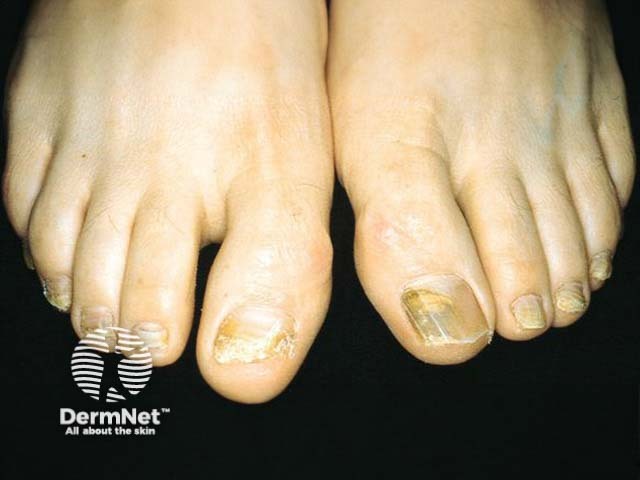Main menu
Common skin conditions

NEWS
Join DermNet PRO
Read more
Quick links
For each of the ten cases, study the image(s) and then answer the questions. You can click on the image to view a larger version if required.
Each case should take approximately five minutes to complete. There is a list of suggested further reading material at the end of the quiz.
When you finish the quiz, you can download a certificate.

Describe the appearance seen.
The patient has onychodystrophy. Note distal onycholysis (lifting of the nail plate from the nail bed), lateral green, and yellowish discolouration and transverse ridging of the nail plate of the left great toenail. The right great toenail is discoloured, and short because the distal plate has broken off.
What investigations should be done?
Portions of the infected nail should be collected for the medical laboratory. If there are signs of fungal infection elsewhere such as interdigital maceration, or peeling of the sole, additional scrapings should be taken from affected areas. The microbiologist will prepare the tissue in potassium hydroxide, report on microscopy within a few days, and the results of culture will be available several weeks later.
Initial fungal culture of clipped nail plate is negative. What are the possible causes for the appearance seen?
Onychomycosis due to a dermatophyte, yeast or mould remains the likely cause. However, microscopy and/or culture may be negative because of inadequate sample, prior treatment, laboratory error and other factors. The differential diagnosis includes psoriatic nail dystrophy, traumatic nail dystrophy, twenty-nail dystrophy, and nonspecific nail dystrophy.
The debris is carefully scraped from under the nail, and sent to the laboratory with surface curettings of the yellow part of the nail. A month later the laboratory reports a growth of Trichophyton rubrum. What treatments may be recommended?
Because the fungal infection is extensive, affecting more than one nail and extending to the nail matrix, the patient should be treated with an oral antifungal drug. Drug Tariff funding in New Zealand for currently recommended therapies requires Specialist Recommendation so specific treatment should be discussed with a specialist dermatologist or microbiologist. A three-month course of oral terbinafine, pulse or continuous itraconazole, or fluconazole results in mycological and clinical cure in at least 70% of cases.
What would you recommend to the patient to prevent relapse?
Successful eradication of disease is followed by relapse in a significant proportion of cases because of host susceptibility and/or exposure to reinfection. The patient should regularly examine for and treat tinea pedis with topical antifungal creams and dusting powder. Drying carefully between the toes is helpful. Eradication of spores from socks and stockings requires washing at a temperature of greater than 60 degrees. Shoes should be wiped out with a 3% formalin solution, and kept dry. The patient should use his own bath towel and bath mat, and wear sandals or slippers in public changing areas.